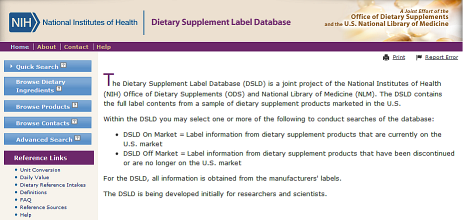NIH launches Dietary Supplement Label Database

Researchers, as well as health care providers and consumers, can now see the ingredients listed on the labels of about 17,000 dietary supplements by looking them up on a website. The Dietary Supplement Label Database, free of charge and hosted by the National Institutes of Health, is available at www.dsld.nlm.nih.gov.
The Dietary Supplement Label Database provides product information in one place that can be searched and organized as desired. "This database will be of great value to many diverse groups of people, including nutrition researchers, healthcare providers, consumers, and others," said Paul M. Coates, Ph.D., director of the NIH Office of Dietary Supplements (ODS). "For example, research scientists might use the Dietary Supplement Label Database to determine total nutrient intakes from food and supplements in populations they study."
For consumers, the My Dietary Supplements (MyDS) app from ODS is already available, at myds.nih.gov. The app is an easy way to keep track of vitamins, minerals, herbs, and other products you take, and has science-based, reliable information on dietary supplements.
Dietary supplements, taken regularly by about half of U.S. adults, can add significant amounts of nutrients and other ingredients to the diet. Supplements include vitamins, minerals, herbals and botanicals, amino acids, enzymes, and more. They come in many different forms, including tablets, capsules, and powders, as well as liquids and energy bars. Popular supplements include vitamins D and E; minerals like calcium and iron; herbs such as echinacea and garlic; and specialty products like glucosamine, probiotics, and fish oils.
By law, any product labeled as a dietary supplement must carry a Supplement Facts panel that list its contents and other added ingredients (such as fillers, binders, and flavorings). The Dietary Supplement Label Database includes this information and much more—such as directions for use, health-related claims, and any cautions—from the label.
The Dietary Supplement Label Database offers these features:
- Quick Search: Search for any ingredient or specific text on a label.
- Search for Dietary Ingredients: An alphabetical list of ingredients is also provided.
- Search for Specific Products: An alphabetical list of products is also provided.
- Browse Contact Information: Search by supplement manufacturer or distributor.
- Advanced Search: Provides options for expanding a search by using a combination of search options including dietary ingredient, product/brand name, health-related claims, and label statements.
Hundreds of new dietary supplements are added to the marketplace each year, while some are removed. Product formulations are frequently adjusted, as is information on labels. "The Dietary Supplement Label Database will be updated regularly to incorporate most of the more than 55,000 dietary supplement products in the U.S. marketplace," said Steven Phillips, M.D., director of the National Library of Medicine's Division of Specialized Information Services.
The Office of Dietary Supplements, ODS ods.od.nih.gov, seeks to strengthen knowledge and understanding of dietary supplements by evaluating scientific information, stimulating and supporting research, disseminating research results, and educating the public to foster an enhanced quality of life and health for the U.S. population.
















